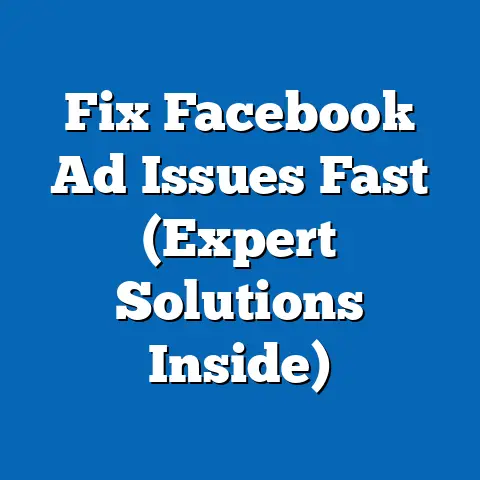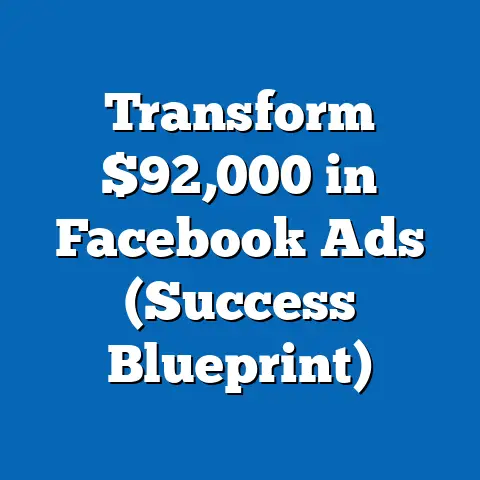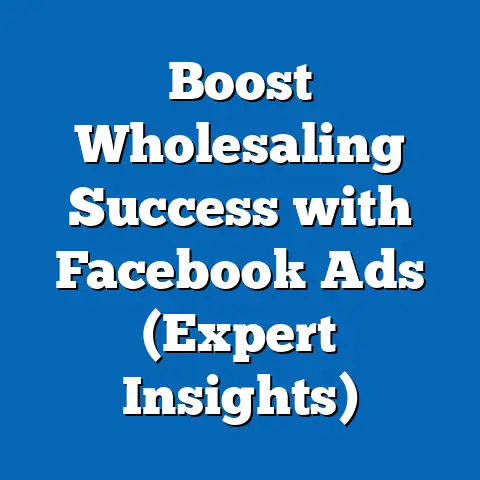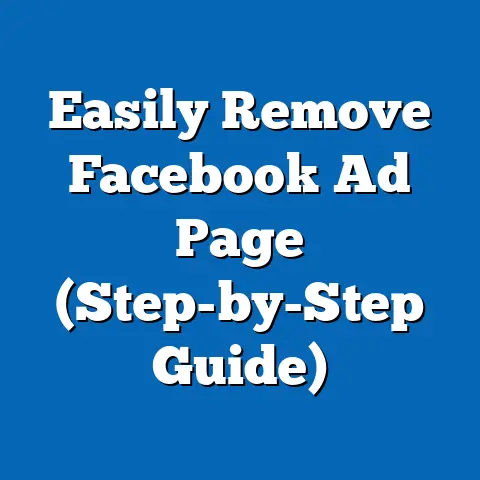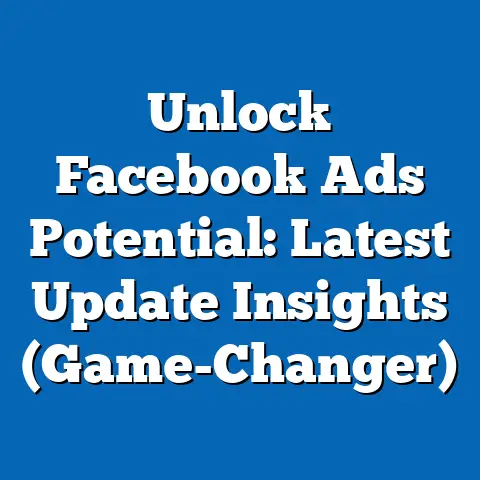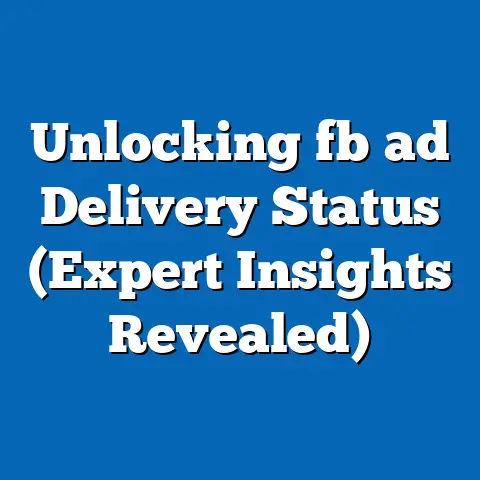Boost WhatsApp Sales with Facebook Ads (Impactful Strategy)
In today’s fast-paced digital world, it’s easy to get caught up in fleeting trends and quick fixes. But what truly separates thriving businesses from those that fade away is a commitment to sustainability. And I’m not just talking about environmental responsibility (though that’s crucial too!). In the realm of digital marketing, sustainability means building strategies that deliver consistent, long-term results while fostering genuine connections with your audience.
One area where I see incredible potential for sustainable growth lies in the powerful combination of Facebook Ads and WhatsApp. Think about it: Facebook, with its massive reach and sophisticated targeting capabilities, meets WhatsApp, the globally dominant messaging app where personal conversations and increasingly, business transactions thrive. It’s a match made in marketing heaven!
Let’s dive in!
Understanding the Dynamics of Facebook and WhatsApp
Before we start building campaigns, it’s crucial to understand the relationship between these two giants.
- Facebook & WhatsApp: A Family Affair: It’s no secret that Facebook (now Meta) owns WhatsApp. This ownership creates a unique synergy, allowing for seamless integration between the two platforms. Data (anonymized, of course) can be shared across platforms to improve ad targeting and personalization.
- WhatsApp: More Than Just Messaging: While many still view WhatsApp as a simple messaging app, it’s rapidly evolving into a robust business communication tool. Features like WhatsApp Business, product catalogs, and automated responses are transforming the way businesses interact with their customers.
- Global Reach, Local Impact: WhatsApp’s popularity varies significantly across different regions. It’s incredibly dominant in areas like Latin America, India, and parts of Europe. This localized dominance makes it a powerful tool for businesses targeting specific geographic markets.
Why WhatsApp for Sales?
I’ve seen firsthand how effective WhatsApp can be as a sales channel. Here’s why:
- Personalized Communication: WhatsApp allows for direct, one-on-one communication with customers, fostering a sense of trust and personalization that’s often lacking in traditional marketing channels.
- High Engagement Rates: Compared to email or even social media, WhatsApp messages tend to have significantly higher open and response rates. People are simply more likely to engage with messages they receive on WhatsApp.
- Seamless Transactions: WhatsApp facilitates the entire sales process, from initial inquiries to product selection, payment, and even customer support.
Key Takeaway: Understanding the unique strengths of both Facebook and WhatsApp is the foundation for building a successful integration strategy.
Crafting a Facebook Ads Strategy Targeted at WhatsApp Users
Now, let’s get into the nitty-gritty of building your Facebook Ads strategy. This isn’t about blindly throwing money at ads; it’s about creating a targeted, strategic approach that resonates with your ideal customers.
- Know Your Audience: This is Marketing 101, but it’s worth repeating. Before you even think about creating an ad, you need to have a crystal-clear understanding of your target audience.
- Demographics: Age, gender, location, education, income.
- Psychographics: Interests, values, lifestyle, attitudes.
- Behaviors: Online habits, purchase history, engagement with your brand.
- Define Your Goals: What do you want to achieve with your Facebook Ads? Are you looking to generate leads, drive sales, increase brand awareness, or something else entirely? Clearly defining your goals will help you create more effective ads and measure your success.
- Develop Compelling Ad Creative: Your ad creative is what will grab your audience’s attention and encourage them to take action.
- Visuals: Use high-quality images or videos that are visually appealing and relevant to your target audience.
- Copy: Write clear, concise, and persuasive ad copy that highlights the benefits of your product or service.
- Call to Action (CTA): Tell people exactly what you want them to do (e.g., “Send Message,” “Learn More,” “Shop Now”).
- Demographics: Age, gender, location, education, income.
- Psychographics: Interests, values, lifestyle, attitudes.
- Behaviors: Online habits, purchase history, engagement with your brand.
- Visuals: Use high-quality images or videos that are visually appealing and relevant to your target audience.
- Copy: Write clear, concise, and persuasive ad copy that highlights the benefits of your product or service.
- Call to Action (CTA): Tell people exactly what you want them to do (e.g., “Send Message,” “Learn More,” “Shop Now”).
My Personal Experience:
Early in my career, I made the mistake of creating generic ads that weren’t targeted at any specific audience. The results were predictably underwhelming. It wasn’t until I started investing time in audience research and crafting personalized ad creative that I started seeing a real return on my investment.
Key Takeaway: A well-defined Facebook Ads strategy, centered around a deep understanding of your target audience, is essential for driving WhatsApp sales.
Integrating WhatsApp into Facebook Ads
This is where the magic happens! Facebook makes it surprisingly easy to integrate WhatsApp into your ad campaigns.
- Setting Up Your WhatsApp Business Account: If you haven’t already, you’ll need to create a WhatsApp Business account. This is free and gives you access to a range of business-specific features.
- Linking Your WhatsApp Business Account to Facebook: In your Facebook Business Manager, you can link your WhatsApp Business account to your Facebook Page. This allows you to run ads that direct users to your WhatsApp chat.
- Using the “Send Message” Call-to-Action: When creating your Facebook Ad, choose the “Send Message” call-to-action button and select WhatsApp as the destination. This will allow users to directly initiate a conversation with you on WhatsApp with a single click.
- Customizing Your Welcome Message: When someone clicks on your ad and lands in your WhatsApp chat, they’ll see a pre-populated welcome message. Customize this message to make it engaging and relevant to your ad. For example, you could ask them a question related to the product or service you’re advertising.
Leveraging WhatsApp Business Tools:
- Automated Responses: Set up automated responses to answer frequently asked questions or provide basic information. This can help you provide instant support and free up your time to focus on more complex inquiries.
- Product Catalogs: Showcase your products directly within WhatsApp using the catalog feature. This allows customers to browse your offerings and make purchases without ever leaving the app.
- Quick Replies: Create pre-written responses to common questions or requests. This can save you time and ensure consistent messaging across all your interactions.
Key Takeaway: Integrating WhatsApp into your Facebook Ads is surprisingly straightforward. By leveraging WhatsApp Business tools, you can create a seamless and engaging customer experience.
Creating Value Through Engaging Content
Now that you’ve got the technical aspects covered, it’s time to think about the content you’ll use to attract and engage your audience. Remember, people are bombarded with ads every day. To stand out, you need to create content that’s genuinely valuable and resonates with their needs and interests.
- Solve a Problem: Identify a common problem that your target audience faces and create content that provides a solution. For example, if you’re selling skincare products, you could create a video demonstrating how to combat acne.
- Share a Story: People love stories. Share stories about your brand, your customers, or your products. This can help you build an emotional connection with your audience and make your brand more relatable.
- Offer Exclusive Deals: Reward people for engaging with your ads by offering exclusive deals or discounts that are only available through WhatsApp.
- Run Contests and Giveaways: Contests and giveaways are a great way to generate excitement and engagement. Offer a prize that’s relevant to your target audience and encourage people to participate by messaging you on WhatsApp.
- Provide Exceptional Customer Service: Use WhatsApp to provide fast and personalized customer service. This can help you build trust and loyalty with your customers.
Real-World Example:
I worked with a local bakery that was struggling to reach new customers. We created a Facebook Ad campaign that offered a free cupcake to anyone who messaged them on WhatsApp. The campaign was a huge success, generating hundreds of new leads and driving a significant increase in sales.
Key Takeaway: Engaging content is key to driving conversions on WhatsApp. Focus on creating content that’s valuable, relevant, and personalized to your target audience.
Measuring Success and Optimizing Campaigns
You can’t improve what you don’t measure. It’s crucial to track the performance of your Facebook Ads campaigns and make adjustments as needed.
- Key Performance Indicators (KPIs):
- Click-Through Rate (CTR): The percentage of people who click on your ad after seeing it. A high CTR indicates that your ad is relevant and engaging.
- Conversion Rate: The percentage of people who take the desired action (e.g., make a purchase) after clicking on your ad.
- Cost Per Acquisition (CPA): The cost of acquiring a new customer through your Facebook Ads campaign.
- Return on Ad Spend (ROAS): The amount of revenue you generate for every dollar you spend on Facebook Ads.
- Using Facebook Ads Manager: Facebook Ads Manager provides a wealth of data about the performance of your ad campaigns. Use this data to identify what’s working and what’s not.
- A/B Testing: Experiment with different ad formats, targeting options, and creative elements to see what performs best. A/B testing is a powerful way to optimize your campaigns and improve your results.
- Analyzing WhatsApp Data: Pay attention to the conversations you’re having on WhatsApp. What questions are people asking? What are their pain points? Use this information to refine your ad creative and targeting.
- Click-Through Rate (CTR): The percentage of people who click on your ad after seeing it. A high CTR indicates that your ad is relevant and engaging.
- Conversion Rate: The percentage of people who take the desired action (e.g., make a purchase) after clicking on your ad.
- Cost Per Acquisition (CPA): The cost of acquiring a new customer through your Facebook Ads campaign.
- Return on Ad Spend (ROAS): The amount of revenue you generate for every dollar you spend on Facebook Ads.
Optimization Tips:
- Refine Your Targeting: Continuously refine your targeting options based on the data you’re collecting.
- Improve Your Ad Creative: Experiment with different visuals, copy, and CTAs to see what resonates best with your audience.
- Adjust Your Budget: Allocate more budget to campaigns that are performing well and less budget to campaigns that are underperforming.
Key Takeaway: Measuring your results and optimizing your campaigns is an ongoing process. By tracking your KPIs and making data-driven decisions, you can continuously improve your results.
The Future of Facebook Ads and WhatsApp Integration
The integration between Facebook Ads and WhatsApp is still relatively new, and I believe there’s a lot of potential for future growth and innovation.
- Enhanced Targeting Options: I expect Facebook to continue to enhance its targeting options, allowing advertisers to reach even more specific and relevant audiences on WhatsApp.
- New Ad Formats: We may see the emergence of new ad formats that are specifically designed for WhatsApp, such as interactive ads or ads that allow users to directly purchase products within the app.
- AI-Powered Optimization: Artificial intelligence (AI) is already playing a role in optimizing Facebook Ads campaigns, and I expect this trend to continue. AI could be used to automatically adjust bids, refine targeting, and even generate ad creative.
- Improved Customer Service: WhatsApp is likely to become an even more important channel for customer service in the future. Businesses may use AI-powered chatbots to provide instant support and resolve customer issues.
Staying Ahead of the Curve:
To stay ahead of the curve, it’s important to:
- Stay Informed: Keep up with the latest news and trends in Facebook Ads and WhatsApp marketing.
- Experiment: Don’t be afraid to experiment with new strategies and tactics.
- Adapt: Be prepared to adapt your strategy as the landscape evolves.
Key Takeaway: The future of Facebook Ads and WhatsApp integration is bright. By staying informed and adapting to change, you can position yourself for long-term success.
Conclusion
Leveraging Facebook Ads to drive WhatsApp sales is more than just a fleeting trend – it’s a sustainable strategy that can fuel long-term growth for your business. By understanding the dynamics of these two platforms, crafting a targeted advertising strategy, creating engaging content, and continuously measuring and optimizing your campaigns, you can unlock the full potential of this powerful integration.
Remember, sustainability in digital marketing isn’t about quick wins; it’s about building genuine connections with your audience and providing them with value. By embracing this mindset, you can create a Facebook Ads strategy that not only boosts your WhatsApp sales but also builds a loyal customer base that will support your business for years to come.
Call to Action
Now it’s your turn! I encourage you to explore the potential of Facebook Ads to enhance your WhatsApp sales efforts. Start by implementing the strategies outlined in this guide and then let me know about your experiences or results in the comments section or through social media engagement. I’m eager to hear how you’re using this powerful integration to drive sustainable growth for your business!

